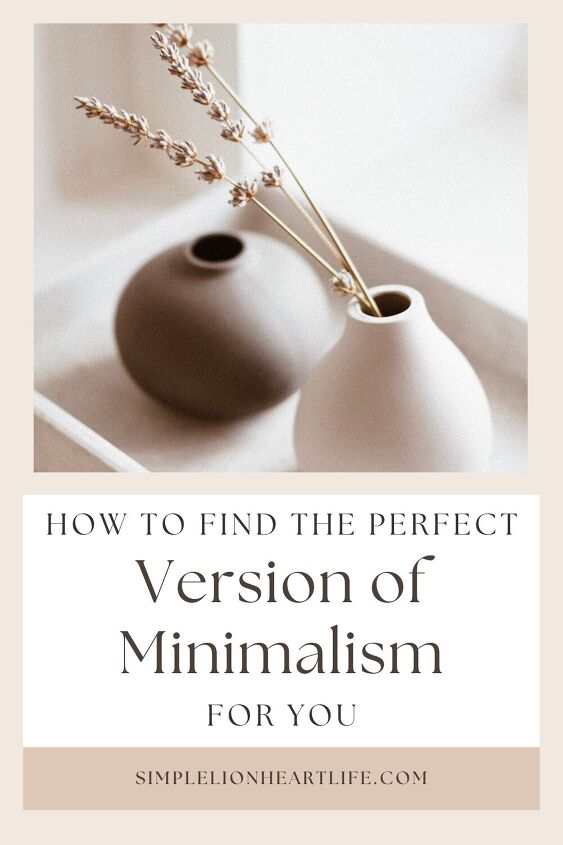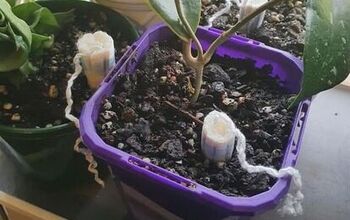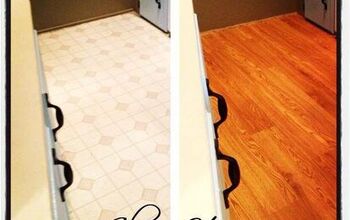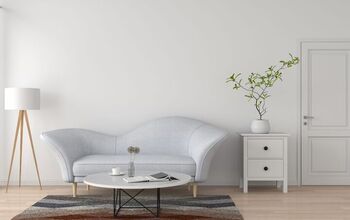How to Find the Perfect Version of Minimalism for You

One wonderful thing about pursuing a simpler, more minimalist life is that your version of minimalism can be unique and personal to you. Your version of a simple, minimalist lifestyle won’t necessarily look like another person’s version of minimalism. And that’s ok! It’s perfect in fact.
Minimalism is not about following someone else’s rules or way of living as a minimalist. It’s about figuring out what is important to you, then getting rid of everything that’s distracting you from the important stuff.
Whatever you decide is important to you will be personal and unique to you. So of course, your version of minimalism will be unique to you too!
Falling into the comparison trap
In one sense, it’s great that there are no firm rules to follow to become an “official minimalist”. Your life as a minimalist doesn’t have to look like another minimalist’s life. There is no test to pass before you can call yourself a minimalist.
But, sometimes when you are just starting on your minimalism journey, it can feel overwhelming trying to figure out how to actually start living a more minimalist lifestyle. Sometimes you are looking for a list of minimalist “rules” or minimalist living tips to follow to help you know what you need to do to embrace minimalism.
I know I was looking for some minimalism rules when I first started minimizing and simplifying!
I wanted to know how little other people lived with, and how much they got rid of as they embraced minimalism. Not only to inspire me to continue decluttering and simplifying. But also to help push me outside of my comfort zone and encourage me to be more ruthless as I was decluttering and simplifying.
But that also made it easy to fall into the comparison trap. Making it tricky to gain inspiration and encouragement from seeing what others did. But without letting doubt, imposter syndrome or other negative feelings creep in.
As a recovering perfectionist, it can be hard to let go of what I feel like I “should” be doing or how I am “supposed” to be a minimalist. For example, if I have two sets of sheets for each bed in the house, but another well-known minimalist says they only have one set of sheets, does that mean I’m not minimalist enough?
There are no rules you must follow to live a simple, minimalist lifestyle
Eventually, I began realizing that there are no minimalism rules. No one else can tell me what minimalism will look like for my life and my family.
My version of minimalism won’t be the same as anyone else’s version of minimalism because we all value different things. We all have different values, goals, priorities, preferences, lifestyles, family sizes and dynamics, etc.
And the key is finding the version of minimalism that works best for you. That simplifies and lightens your life. Giving you more time and space for what matters most to you. Not becoming another set of rules to try to follow, another way to “keep up with the Joneses”, or another thing adding stress to your life.
Your version of minimalism will be unique to you
Even though all our versions of minimalism are different from each other, we can all still call ourselves minimalists if we are actively working toward embracing a simpler, minimalist lifestyle.
The only requirement to be a “minimalist” is that you first identify what is important to you and what you value. Then get rid of the things that aren’t important or valuable to you. Along with the things unnecessarily distracting you from what is most important to you and what you value.
My version of minimalism will be unique to me because what is important and valuable to me will also be unique to me. Just as your version will be unique to you based on what is important and valuable to you.
Don’t compare your version of minimalism to anyone else’s
The great thing about minimalism is you can’t get it “wrong”. If you have minimized down to what you feel is enough for you and your family, then that’s your version of minimalism.
Your version of minimalism can shift, change and evolve over time. Maybe next year you’ll want to minimize what you own even more. Or maybe next year you’ll be in a season of life where you need a few more things.
It can all still be minimalism.
You can’t be a good minimalist or a bad minimalist compared to someone else. Because there’s no way to fully compare your version of minimalism to someone else’s. Your versions of minimalism will always be different from each other because you are different and unique individuals. Each of us with our own interpretation of what minimalism means to us.
There is no minimalism police to give you a ticket if someone else decides you have too many books. And there are no minimalism awards given to those who “win” at minimalism.
It’s simply a matter of figuring out what your version of minimalism looks like for you. And ultimately, how you can improve your life by reducing the clutter, excess and distractions from your home and life in a way that works for you.
Your goal in pursuing minimalism is to give yourself the time, space and freedom to enjoy your life and the things, activities and people you value most. However, you reach that place is what your version of minimalism looks like.
Learn from other minimalists, then create your own version of minimalism
It can be helpful to read about or see other people’s versions of minimalism to inspire and encourage you on your own minimalism journey.
It’s great to learn what is working for them and what stumbling blocks they encountered along the way. And hear any minimalist living tips they have to share.
In fact, I think seeing how other people “do” minimalism is one of the best ways to learn more about minimalism. It’s a great way to challenge yourself to step out of your comfort zone and motivate yourself to experiment with living with less. Maybe in ways you hadn’t previously considered or even knew were possible!
However, the key is taking what you learn and creating your own version of minimalism. One that works for your family, your lifestyle and your priorities. Instead of just trying to copy someone else’s version of minimalism.
How to find your own version of minimalism
However, what if you are just starting out on your minimalism journey and are feeling overwhelmed without a set of guidelines to follow? Or what if you’ve been decluttering and minimizing for a while, but aren’t sure how you’ll know when you’ve reached a place of enough in your version of minimalism?
With a little contemplation and thought, you can figure out what you want your version of minimalism to look like.
Asking yourself some key questions will help you get clear about what you want your version of minimalism to look like, and what you’ll need to do to get there.
3 questions to help you find your version of minimalism:
1. Why are you choosing minimalism?
First, think about what led you to minimalism, simplifying and decluttering in the first place.
What is motivating you to embrace minimalism?
Are you tired of cleaning up but never getting ahead? Or are you overwhelmed by the amount of work required to maintain your home and possessions? Are you sick of spending the majority of your time dealing with “stuff” and want more time and energy for your family, friends or hobbies? Are you moving and want to declutter before your move? Or are you feeling bogged down by your life and stuff, and looking for a way to free yourself? Do your days feel overwhelming and stressful and you know there must be a better way than simply “making it through” each day?
There are so many reasons that can lead you to minimalism. The first step to figuring out how you want your version of minimalism to look is to get clear about what you want to accomplish by embracing minimalism. Get clear about what your goal of minimizing is.
Why I choose minimalism
For me, I was so tired of picking up after my toddler when she was constantly getting into every closet, cupboard and shelf she could reach when they were all full of stuff!
One day I realized I was spending way too much time picking up, putting away and organizing stuff I didn’t even use or love. What was the point?! I wanted to spend less time managing stuff and more time enjoying my life and my family.
Remind yourself of the reason why you are minimizing often. When you’re decluttering and conflicted about getting rid of something, think about why you’re doing this in the first place.
Reminding yourself of your “why” can help you make hard decluttering decisions. And when you’re in the depths of decluttering, and are feeling overwhelmed or tired, remembering why you’re working so hard to embrace minimalism can help keep you motivated and on track.
2. What is important to you?
Joshua Becker says, “Minimalism is the intentional promotion of the things we most value, and the removal of anything that distracts us from it”. Based on this, before you can embrace minimalism, first you must get clear about what you actually value most!
Figure out and get really clear on what is most important to you. What are your values, goals and priorities? Get specific!
Maybe it’s your family and being able to spend quality time with them. Maybe it’s your career and being able to give yourself time and space to pursue it. It could be a hobby you love that you want more time for. Or having the time and freedom to travel more.
For me, being able to have more time, energy and patience to give to my family is a big priority. In order to do this, I need to have a home that is easy to maintain. Then I can easily stay on top of chores and housework to be able to spend quality time enjoying my family without feeling stressed or overwhelmed with the stuff and mess in my home.
I want to give my family the best version of myself, in terms of my time, my energy, my presence, my focus and my patience. Not what’s left over after I’ve spent the majority of my time managing the stuff in our lives.
Again, this is something only you can decide. And it will be different for each of us. You need to clarify for yourself what is most important to you, and what you value most.
What is it you’re trying to make more time and space for in your life by embracing minimalism? Write it down to remind yourself and help you stay motivated and inspired on your journey.
3. What does “enough” look like for you?
This is something you need to figure out as you go through the process of decluttering and minimizing your home. Start questioning what enough looks and feels like for you, so you can let go of everything beyond what is enough.
Again, only you will know what is enough for you. Some people decide enough is owning less than 100 possessions. Others decide their place of enough is much more than that.
There’s no right or wrong answer to what enough looks like for you. It’s simply figuring out what is right for you.
Enough will mean only keeping things that add value to your life because you use them regularly or they make you happy. But again, what is enough will be personal and unique to each of us.
After you have decided what enough looks like for you, it’s also a good idea to question and challenge your idea of enough regularly.
For example, sometimes you keep things because you’ve always had them and are just used to them being there. Or maybe something came as a set, so you think you need to keep the whole set.
It’s always a good idea to challenge your idea of enough and consider if you could comfortably live with less.
An example of figuring out what is enough
Dishes are a great example of this. When we got married we had a set of dishes with 12 place settings. They all fit in the cupboard easily and were a set, so I didn’t even consider decluttering them at first. But because we had a cupboard full of clean dishes, it was easy to use a new plate or bowl any time we wanted to. This left us with a lot of dirty dishes each day.
Over time, the more I embraced a minimalist lifestyle, I realized we didn’t actually need 12 place settings. So I put half the place settings away just to try living with less.
The funny thing is, we didn’t even notice. And 6 place settings have been just fine for our family. We have fewer dirty dishes each day simply because there are fewer dishes, so there are fewer dishes to pile up beside the sink each day.
Challenge and question what is enough
It’s always a good idea to occasionally question and even challenge yourself to see if your place of enough is really enough, or if you could possibly even live with less.
It doesn’t always mean you have to remove more items. Sometimes it just means intentionally thinking about what enough is for you. Challenging and questioning how much you have and why you have it.
Be flexible with your version of a simple, minimalist lifestyle
Answering these three questions can help you figure out what you want your version of minimalism to look like for your life.
It’s important to remember that minimalism isn’t something you attain and then you’re done. It’s a lifestyle you adopt and requires your ongoing attention, maintenance and intention to sustain it. But answering these three questions will help you stay focused and motivated to continue living and pursuing your version of minimalism.
And don’t forget that your version of minimalism can shift and change as your life changes too. Minimalism isn’t static or unchanging. It shifts and evolves as your life shifts and evolves.
Your answers to these three questions will also shift and evolve over time. Revisit these three questions periodically to make sure your answers still apply to your life.
Answering these three questions is a great way to understand, clarify, and remind yourself what your version of minimalism looks like. Then use the answers to work through the hard moments and celebrate the victories of living a life with less.
How would you answer these three questions? What does your version of minimalism look like? Let me know in the comments below!






















Comments
Join the conversation
I probably will try this. I feel your article is repetitive.